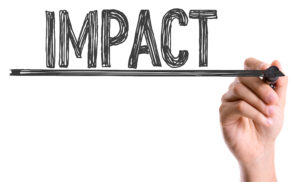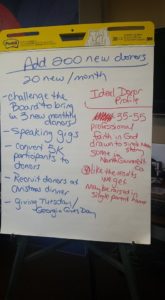Building your fundraising skill is easier when you think like a donor.
The days of people giving simply because your nonprofit does good work are over.
Nowadays, people want to know that you’re having an impact.
They want to know that their money is making a difference.
That means you can’t use the same old strategies and messages that you used in years past. You need a fresh message that resonates with donors and moves them to give.
If you can answer questions before a donor asks them, you can quickly build a sense of trust and increase the chances of that person making a gift to your nonprofit.
Again, fundraising gets easier when you use your most important fundraising skill and think like a donor.
The problem with most messaging

It’s what you know.
You live and breathe your organization and you know inside out, upside down, backwards, forwards, and 10 ways to Sunday.
Simply put, you share what you know.
Often, it’s too much.
Donors don’t care about most of what you know.
They are interested in outcomes and impact.
They want to know about the lives that are being changed.
So the big problem with most messaging is that you’re focused on the wrong thing.
Instead, ask yourself this question. It’s the ONLY question you need to answer:
What does my donor want to know?
So, what DOES your donor want to know?
How do you find out? How do you start to think like a donor?
It’s actually pretty easy.
Put yourself in the donor’s shoes and look at your nonprofit with fresh eyes.
What would you want to know?
Or think about a nonprofit that you are interested in but haven’t given to yet. What would you need to know to give them $5,000?
You’d want to know they’re trustworthy, right? That they’ll use the money wisely. That they get good results, and more.
Now we’re on the right track.
The “Think Like A Donor” Exercise
Try this exercise to help you get into the donor’s head.
- Grab a piece of paper and a pen.
- Number 1 to 50.
- Then start writing down questions your donor might have about your organization and programs.
- Keep going until you get 50. If you can think of more than 50, you get bonus points.
Once you get your list of 50, prioritize them, with 1 being the most important thing donors want to know and 50 being the least important. Be careful with this – it’s not what you WANT donors to know, it’s what THEY want to know.
- One a separate page, rewrite the top 10 questions and answers. This is your gold mine. Your mission, should you choose to accept it, is to share ONLY the stuff that falls in the top 10.
THIS is what your donors really want to know. THIS is the information you need to be sharing. THIS is what needs to be in your newsletter, social media, annual reports, website, and everywhere else you’re telling your story.
THIS is what will move donors to give.
Stop talking about your 25th anniversary and who’s on your Board. Stop talking about the conference you just went to or an industry award you won. None of that should be in the top 10.
Now, compare this content to what you typically share. I bet it’s pretty different. Adjust your messaging accordingly.
This exercise can change how you think about your organization and how much money you raise.
When you share the answers to donor’s questions before they can even form the questions in their mind, you build trust, you set yourself apart from other nonprofits, and donors feel comfortable giving.
Want to make this exercise even better? Do it with your Board and write the answers on flip charts like this:

I did this with a client a couple of weeks ago, and we filled up 3 big flip chart pages. It gave us pretty good insight into what the messaging should be for a campaign they’re starting soon.
The worst thing you can do is the same thing you’ve been doing. After all, more of the same equals more of the same.
If you want to raise more money this year, try using your best fundraising skill and think like a donor.







Leave A Comment